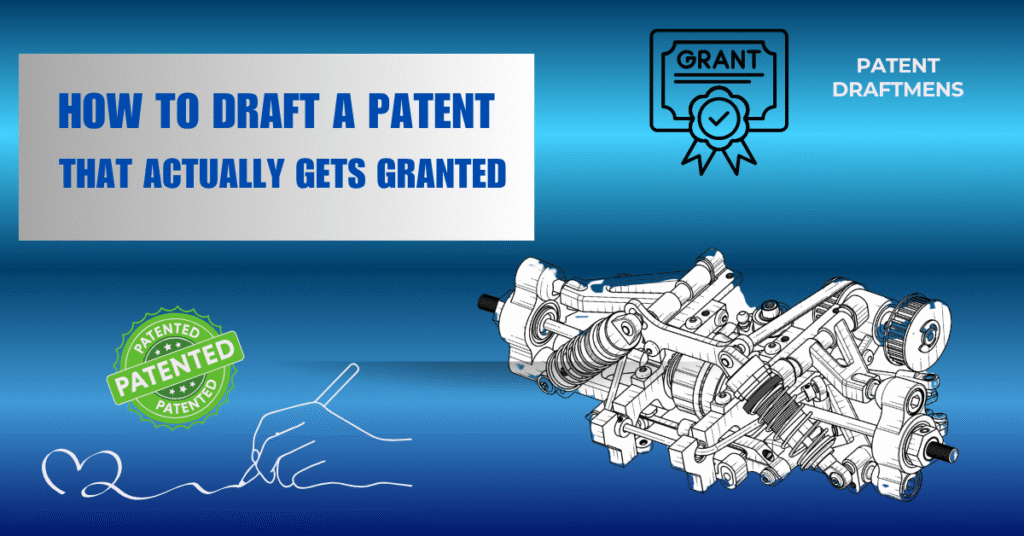Introduction:
Your Full, No-Fluff Guide to Getting It Right the First Time
You’ve just come up with something new. Maybe it’s a gadget, a process, a piece of software, or a clever improvement to something that already exists. It solves a problem. It’s useful. Maybe even a little genius.
You’re excited. You want to secure it before someone else comes up with the same idea. You want to make sure your name is on it—and that no one can steal, copy, or claim credit for what you built. That’s where patents come in.
But let me be honest with you—most patents don’t get granted easily.
And the reason isn’t always what you think. It’s not always because the idea isn’t good enough. It’s not necessarily because someone else already built it.. And it’s definitely not because the inventor isn’t smart.
It’s because the patent draft is weak.
Yup. The problem is usually in the writing. The way the idea is explained. The way the claims are written. The level of detail (or lack of it). The structure. The format. The missing parts. The vague language.
A weak patent draft can ruin even a great invention.
That’s the truth no one tells you when you’re just starting out.
But here’s the good news:
With the right guidance, anyone can learn to draft a solid patent. You don’t have to be a lawyer or a genius to do this. You just need to understand what the patent office wants to see—and how to write it clearly.
In this blog, I’m going to walk you through how to draft a patent that actually gets granted. No fluff. No legal jargon. Just real talk, simple steps, and practical advice that works in the real world.
Whether you’re:
- an inventor trying to protect your first idea,
- a startup founder looking to file your own patent to save money,
- or a new patent drafter learning the ropes,
…this guide is for you.
Let’s get started—because your invention deserves real protection.
What Is a Patent Draft (Really)?
A patent draft is not just a form. It’s the full written document that explains what your invention is, how it works, and what parts you want to protect legally.
Think of it like this:
- The patent protects your invention.
- The draft is the blueprint that decides if the patent gets granted or not.
A well-written draft gives you stronger protection. It’s that simple.
Before You Draft: Get These 3 Things Right
1. Make Sure Your Idea Is New
Sounds obvious, right? But you’d be surprised how many “new” inventions are already out there in some form.
Do a prior art search.
Use free tools like Google Patents, Espacenet, or the USPTO website to do your search.
Tip: If something similar exists, find what’s missing. Your improvement might still be patentable.
2. Check If It’s Patentable
Not everything can be patented. You can’t patent:
- Abstract ideas (like algorithms without a use)
- Natural discoveries
- Scientific theories
- Business methods (in some countries)
But you can patent:
- Products
- Machines
- Processes
- Software (if it solves a technical problem)
3. Write It So a Skilled Person Can Recreate It
This is a legal requirement. The invention should be described clearly enough that someone skilled in the field can make and use it without needing to guess.
This is called enablement. And it’s the #1 reason drafts get rejected.
Structure of a Winning Patent Draft
Let’s break it down into sections. This is what your draft should include:
1. Title of the Invention
Keep it short and clear. Describe what it is, not what it does.
Bad: “An innovative method to improve online learning engagement.”
Good: “System for Real-Time Feedback in Online Classrooms”
2. Field of the Invention
Tell what field your invention belongs to. One or two lines are enough.
Example: “The present invention relates to wearable medical devices, more specifically to heart rate monitoring systems.”
3. Background of the Invention
Explain what problem exists in the current system.
Keep it honest. Don’t oversell. Simply explain what the problem is and how your idea solves it.
“Existing fitness bands often lose accuracy during workouts due to motion artifacts. This limits their use in high-intensity training.”
4. Summary of the Invention
Now, tell what your invention does—in your own words. Keep it short but powerful.
“The present invention offers a wristband with dual-sensor fusion to track heart rate with improved accuracy during high-motion activities.”
5. Brief Description of Drawings
List all your figures with one-line descriptions.
Fig. 1: Top view of the wristband
Fig. 2: Circuit diagram
Fig. 3: Flowchart of signal processing method
6. Detailed Description of the Invention
This is where you go deep.
Explain every part, step, and function in detail. Assume the reader knows the field but not your idea.
Use simple language. Avoid marketing fluff.
“The device features a photoplethysmogram (PPG) sensor and a three-axis accelerometer mounted on the inner surface of the housing. The signals from both sensors are processed by a microcontroller…”
Tip: Write like you’re teaching a new engineer on your team.
7. Claims – The Heart of the Patent
This is the most important part.
Claims define what you are protecting. If it’s not mentioned in the claims, it’s not legally protected by the patent. There are two types:
- Independent claims – broad, main protection
- Dependent claims – add details or limitations
Claim 1 (Independent):
A wearable heart monitoring device comprising:
(a) a photoplethysmogram (PPG) sensor,
(b) a motion sensor, and
(c) a microcontroller configured to process signals from (a) and (b)…
Claim 2 (Dependent):
The device according to Claim 1, where the motion sensor is a three-axis accelerometer.
Pro tip: Start broad, then add details in dependent claims.
8. Abstract
A short 150-word summary. One paragraph, no claims, just what it does.
“The invention discloses a wearable device for real-time heart monitoring using dual-sensor data. It improves accuracy in motion-heavy environments through signal fusion and machine learning-based filtering.”
Tips to Make Your Draft Strong (Not Just Fancy)
A lot of people try to make their patent drafts sound impressive—full of technical buzzwords and long-winded explanations. But here’s the truth: flashy wording won’t get your patent approved.
Below are some important tips that will help you write a strong patent draft—one that not only looks good but actually holds up during examination.
1. Use Clear, Technical Language
Keep it simple and technical.
Avoid fluff, hype, or storytelling. You’re not writing a pitch deck, you’re writing a legal document.
Bad example:
“This revolutionary smart app transforms the way people connect and engage!”
Good example:
“The system comprises a server, a mobile application interface, and a data processing module for matching users based on predefined preferences.”
Why it matters:
Patent examiners want to understand your invention, not guess what you mean. If your language is vague or too promotional, they might reject it or ask for clarifications—which slows everything down.
2. Avoid Absolute Words Like “Must,” “Only,” or “Always”
Using words like “must,” “only,” “always,” and “required” in a patent can be risky.
They make your claims narrow. They create legal traps.
Let’s say you write:
“The sensor must be placed under the device.”
If someone makes the same device but puts the sensor on top, your claim may not apply. You’ve accidentally limited yourself.
Instead, write:
“The sensor is placed under the device in one embodiment.”
Why it matters:
Overly restrictive words lock your claims into one version of your invention. That makes it easier for competitors to work around it—and for examiners to reject it for being too narrow or unclear.
3. Cover Variations and Alternatives
Your invention probably works in more than one way. Mention those possibilities.
Use phrases like:
- “In another embodiment…”
- “Alternatively…”
- “The system may also include…”
- “In some configurations…”
Example:
“In one embodiment, the device uses Bluetooth. In another variation, it may use Wi-Fi or NFC for wireless communication.”
Why it matters:
By including variations, you expand the scope of your protection. You also show the examiner that your idea is flexible and not limited to just one form.
4. Add Diagrams – Even Simple Ones
You don’t need to be a graphic designer. Just include clean, labeled sketches that show:
- How your invention is built
- How the parts connect
- How it works in different steps
Your drawings can include:
- Top view and side view of the product
- Block diagrams of system components
- Flowcharts of processes
- Circuit diagrams (if applicable)
- User interfaces or screen layouts (for software)
Why it matters:
Patent examiners rely heavily on visuals. Sometimes, a simple drawing explains more than a full page of text. And if you don’t include diagrams, your draft may be considered incomplete.
5. Think Like a Competitor (Then Draft Around Them)
Here’s a powerful trick:
Before you finish your draft, pause and ask yourself:
“If someone wanted to copy this idea—but avoid infringing my patent—how would they do it?”
Then cover those workarounds in your claims or descriptions.
Example:
If your device uses a button to activate a sensor, someone might try using a touch sensor instead.
So you write:
“The triggering mechanism may include, but is not limited to, a physical button, a capacitive touch sensor, or a voice-activated input.”
Why it matters:
This mindset protects your invention from “design-arounds”—clever tweaks others might use to steal your concept without technically infringing your patent. Covering multiple possible implementations keeps your protection broad and strong.
Common Mistakes That Get Patents Rejected
- Too much marketing talk, too little technical detail
- Claims that are vague or too broad
- No enablement – not enough info to build the invention
- Inconsistent terminology across the draft
- Missing essential components in drawings or claims
Should You Hire a Patent Draftsman?
If this feels like a lot… it is.
Patent drafting is a technical and legal skill.
If you’re serious about protecting your idea, hiring a trained patent draftsperson is worth it. They:
- Know the rules
- Know how to write strong claims
- Know how to avoid rejection traps
That’s why big companies never file without professional drafting.
Final Checklist Before You File
- Is your invention actually new?
- Have you explained how it works in detail?
- Are the claims clear and well-structured?
- Do your drawings support the written parts?
- Have you checked for similar existing patents?
Conclusion:
In short a good patent draft is like a smart shield.
It not only protects your invention but also scares off copycats.
But to get a patent that actually gets granted, your draft must be:
- Clear
- Detailed
- Legally smart
- Technically sound
You don’t need to be a lawyer. But you do need to write like one—on paper at least.
Got questions or need help drafting your own patent? Drop a comment or reach out. I’m happy to help.

